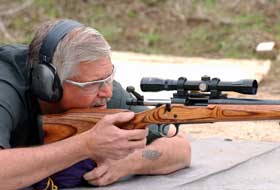
...or even Airsoft guns. One of the commenters on the previous post questioned the effect of subcaliber training when you changed back to your "real" gun either in a personal defense or competition context. I think that definitely deserves a bit of expansion (
don't you?).
When we talk about "training," we're really talking about training 3 separate components:
• Fundamentals
• Techniques
• Tactics
By fundamentals we mean the mechanics of shooting — grip, stance, manipulating the trigger, using the sights and follow-through. There is now a substantial amount of research, anecdotal and otherwise, that the fundamentals can be learned and practiced through visualization and dry-fire. In fact, there is a compelling argument to be made that the fundamentals are best learned through regular visualization and dry-fire:
• The brain doesn't differentiate between visualization, dry-fire or live-fire
• Visualization and then dry-firing allow the shooter to perfectly execute the fundamentals repeatedly
• The explosion and recoil of live-firing are a detriment to perfect practice (which is the only sort of practice that makes perfect), especially with new shooters
When we move to techniques, we mean both the general techniques of firearms' manipulation — checking, loading, unloading, safety/safeties manipulation, etc. — and the techniques specific to the task for which we intend to use the firearms. Those tasks might include the draw from a holster, reholstering, reloading techniques specific to tactical and/or competition, movement, target sequencing, etc. We learn and practice techniques through dry-fire, then vet ourselves in those techniques on the square range.
If you want to truly learn how to reload a pistol for have an efficient drawstroke, you need a hundred (of a thousand) repetitions in dry practice to every live shot fired. Live practice on the square range confirms that our dry practice has been correct and verifies that the fundamentals are still in place.
Tactical practice, as expressed in force-on-force training, is best learned and practiced with dummy guns specifically designed for such training — sim guns, Airsofts, even dummy guns.
IMHO, based on years of training and working with trainers at every level, subcaliber practice brings you 99% or more of the benefits of full caliber training. The remaining little bitty slice is handling recoil, which if you have the fundamentals down is less of an issue than you might think...there's not a different set of fundamentals for heavier recoiling guns! Tatsui Sakai did, after all, win the Steel Challenge — arguably the hardest, most competitive pistol match in the world — after training in Japan, which does not allow its citizens to possess real firearms, for a year with Airsoft guns. He told me it took him "less than a day" to transition between his Airsoft gun with zero recoil, zero noise and zero muzzle flash, and a live firearm.
The fundamentals teach us to how to control a firearm...as we add more recoil, nothing should change. In a personal defense situation, or even when the buzzer goes off in a match, you will likely not notice the recoil, the noise or the blast, and if your fundamentals are sound the bullet will go where you intended it to go.
My experience has been that a shooter who goes back to his/her duty or competition gun after a session training with .22s discovers the more powerful gun has less recoil than before (especially if that shooter has practiced extensively with full power ammo in the primary gun). Of course, the recoil didn't miraculously go away...rather, subcaliber practice (after appropriate visualization and dry-fire) has allowed the shooter's attention to be focused on controlling the gun through the application of the fundamentals rather than becoming fixated on the recoil, noise and flash.
I have proven to my own satisfaction that what we think of subjectively as "recoil" is not only the firearm's measurable reactions to the firing of the cartridge — Newton's Third Law of equal and opposite reaction — but rather an amalgam of our responses to multiple factors, including the amplitude, or height, of the recoil wave, the frequency, or speed, of the recoil wave, [that's the "equal and opposite" stuff] the loudness of the explosion, the size and proximity of the muzzle flash and — this is important — our expectations of the event. Weird, huh? You can "control" recoil by mitigating any one or more of those factors, but I would say the most important factor in recoil control is the last one, expectations. Subcaliber practice allows the shooter to "train" his or her expectations, which actually does "reduce recoil."
REMEMBER: Your mileage may vary....objects in the rearview mirror are closer than they appear...









